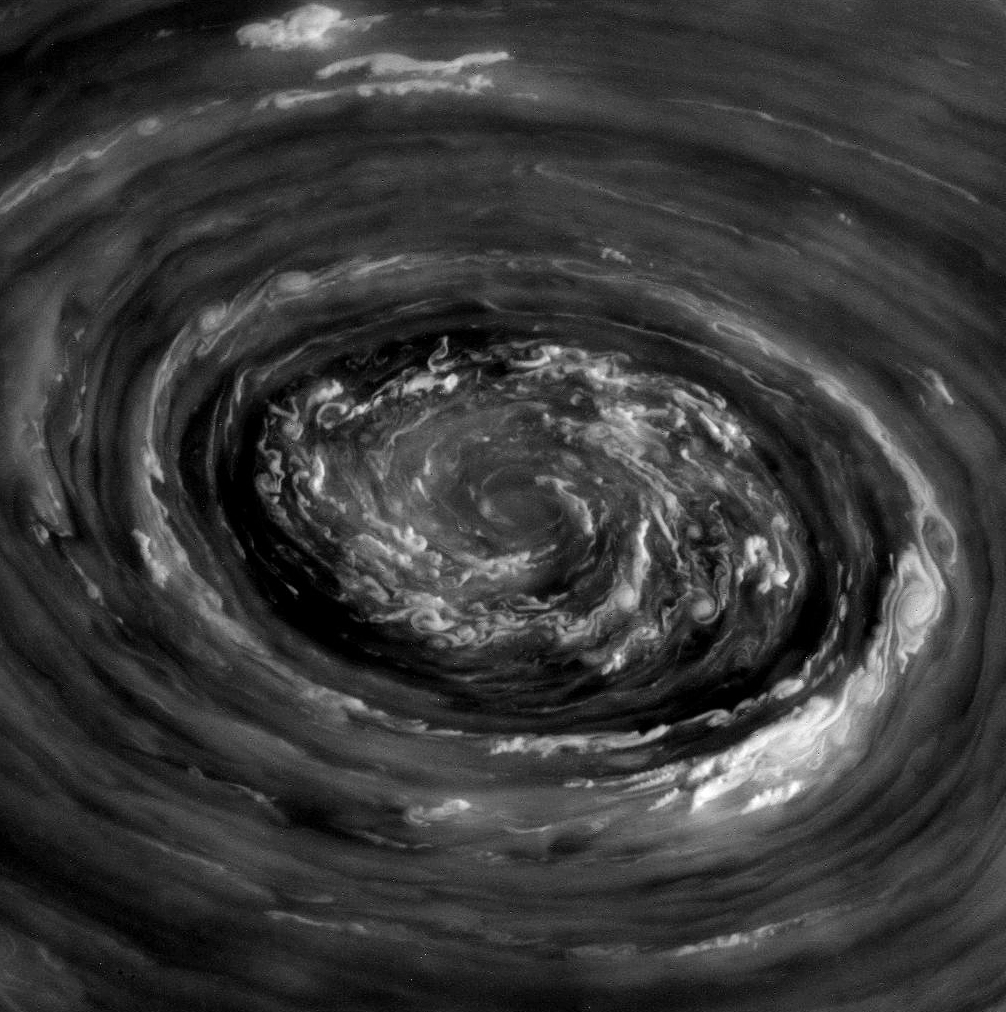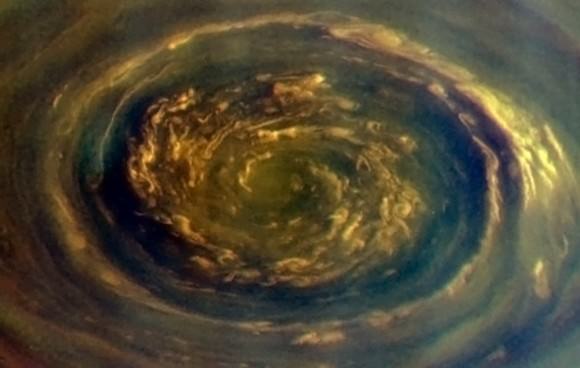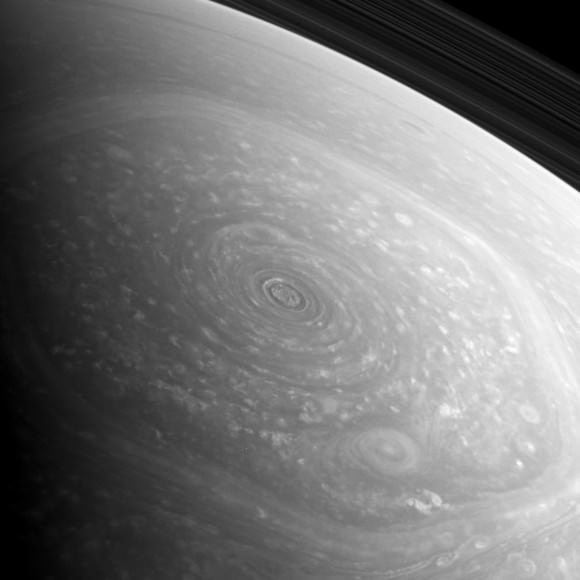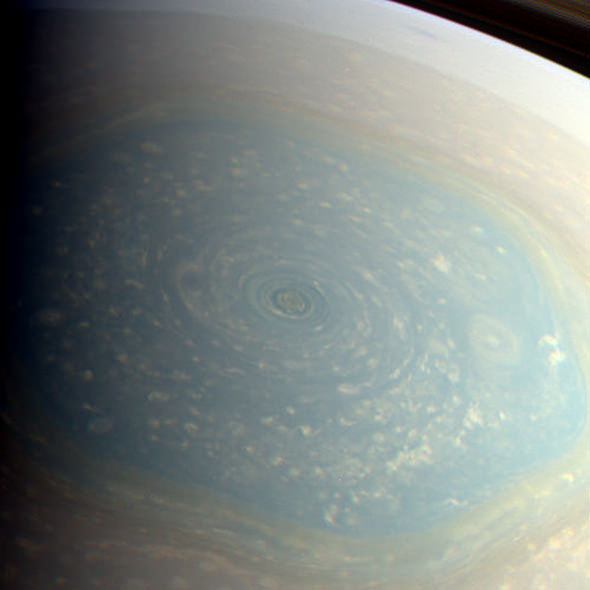Ok, are you ready for this?
I know… WOW.
This swirling maelstrom of clouds is what was seen over Saturn’s north pole earlier today, November 27, by NASA’s Cassini spacecraft. This is a raw image, acquired in polarized light, from a distance of 238,045 miles (383,097 kilometers)… all I did was remove some of the hot pixels that are commonly found on Cassini images taken with longer exposures.
Again… WOW.
My attempt at a color composite can be seen below, plus another treat:
It’s rough, and a little muddy because the clouds were moving between image channels (not to mention the blue channel image was rather underexposed) but here’s a color-composite of the same feature, made from images taken from a slightly different perspective:
Color composite of Saturn’s north polar vortex
Pretty darn cool… Cassini does it yet again!
The images above show an approximately 3,000-4,000-km-wide cyclone above Saturn’s north pole. Saturn is also known to have a long-lived hexagonal jet stream feature around its north pole as well, but that is not shown in those images as it runs along a lower latitude. Instead, you can see that HERE:
Saturn’s northern hexagon
Captured with a wider angle, in this image the hexagon structure can be made out as well as the cyclone, which sits at the center just over the pole. Saturn’s hexagon is about 25,000 km (15,500 miles) in diameter… large enough to fit almost four Earths inside. This image was also acquired today.
An RGB composite of this feature is below:
Saturn’s northern hexagon – color composite
It’s been a few years since we’ve gotten such a good look at Saturn’s north pole… thanks to Cassini’s new orbital trajectory, which is taking it high above the ring plane and poles of Saturn, we now have the opportunity to view the gas giant’s dynamic upper latitudes again. I’m sure this is just a taste of what’s to come!
(Image credit: NASA/JPL/Space Science Institute. Color composites by Jason Major)





How big is that thing?
DAvoyager, It looks to me that the Raw Image cloud formation to the dark ring that surrounds it is around 3100 miles across. That means its almost from San Francisco to New York.
Unreal. Quite stunning.
That’s what she said…
Where’s the hexagon?
M Peter Selman, It is Image 3 and 4 here, note in image three the gray jet stream looking ring that circles the small center vortex at the very center of the image, that smallest vortex is shown in image 1 raw and 2 colorized. The largest ring on the very outside is the hexagon ring.
When I was first here, there was only one picture. Much better, now.
Is there a link for an insane resolution of this image?
No. The raw images posted on the Cassini site are limited to a max of about 1000 pixels.
@Dima R, Here is what I found in the Raw Image posts from Cassini.
http://saturn.jpl.nasa.gov/photos/raw/?start=1
help is it possible to see saturns moon with naked eye can you tell me what this could be???
That’s an interesting question. It is not possible to resolve any of Saturn’s moons with the unaided eye. The maximum apparent polar diameter of Saturn itself is about 18 arc seconds, and the rings are about 45 arc seconds. The human eye doesn’t seem to be able to resolve two points closer than 30 arc seconds, though theoretically it could maybe resolve down to 20.
It might be possible for someone with outstanding vision, appropriate ring presentation and perfect viewing conditions to perceive Saturn as an oval, and I have heard somewhere that it was described by a naive observer as a disc with two smaller discs on either side, which sounds about right. That’s what my computer screen looks like most of the time, I have terrible eyesight.
There are a few people who can see Jupiter’s four largest moons. They are 5th and 6th magnitude, so if you are very lucky, have A++ vision and look at twilight when the glare of Jupiter itself is not so bright you might be able to see them.
Seeing Venus as a crescent would be hard. in quarter phase it would be about 45 arc seconds in diameter, a teensie half-moon. A good imagination will help.
Your pic could be anything. A streetlight, a car headlight, a spaceship, a flashlight. It’s hard to say. Did you take the picture yourself? Where was the camera pointing?
@Dima R, Here is what I found in the Raw Image posts from Cassini.
http://saturn.jpl.nasa.gov/photos/raw/?start=1
I’m watching http://ciclops.org for nicely calibrated and cleaned images. Even raw, quite a spectacular image!
I’m wondering why there isn’t an “eye of the storm” for this Catagory 89 perpetual hurricane.
Maybe because what’s relatively drifting on top covers a much more violent jet underneath?
help is it possible to see saturns moon with naked eye can you tell me what this could
help what this be?
I thought the same thing about the Red Eye of Jupiter. Most likely, this is due to the sheer size of the thing. They eye is full of mini storms.
thunk
As the photo is taken from Earth-Moon distance, imagine seeing that in our sky…
First we’d worship it, then we’d ignore it. Then we’d go there, then we’d stop going there.
Hey Jason,
This is funny 🙂 It made me laugh but seriously it’s a kind of strange nature things that make you think… maybe this is all a simulation and we are indeed like characters on a video game?
See my Telescope
Harry
If you look closely on the far right you can see Landos’ Gas Mining Facility.
WOW is right! The words I used weren’t as appropriate, but I think we had the same reaction.
Our reality is digital, not analog. The Planck length says that things, at a VERY small distance, are at point A or point B and nothing inbetween. Makes you think.
NICE, Jason!
Cassini is amazing – over 8 years and still going strong! I love that space craft.
Does the hexagon spin too? Do the corners point in different directions depending on the time of year?
The hexagon spins, and seems to be tied to Saturn’s rotational rate (which is about 10 hours long)
WOW! That’s pretty fast! Thanks for the response.
Be great to see a wind speed overlay on this image! i.e. How fast ARE the winds near the center? What relationship/ratio are they to Saturn’s 10h 14m rotation rate? Does the hexagonal feature rotate at the same rate as Saturn?
Beautiful. Thank you.
Somewhere there is a news reporter dreaming of reporting from there.
sweet jesus
OK Climate computer geektoids…. model the hexagon weather pattern! I would LOVE to see a simulation in real time! Is there even a theory?
The photos are beyond fantastic!!
simply amazing …
There are more things in heaven and earth, Horatio,
Than are dreamt of in
your philosophy.
– Hamlet (1.5.166-7), Hamlet to Horatio